

Accommodations to Help Your Child With Executive Functioning Issues. DI Card Structures. DI Card Strategies. MIN DI Cards Metacognition4. MIN DI Cards Metacognition3. Psychology Newsletter 10 Learning Skills. Trend Enterprises Attitudes Are Contagious Poster. Setting Students With ADHD Up for Success. Emotional and Behavioral Disorders in the Classroom. By Becton Loveless "Emotional and Behavioral Disorder" is an umbrella term under which several distinct diagnoses (such as Anxiety Disorder, Manic-Depressive Disorder, Oppositional-Defiant Disorder, and more) fall.
How Albert Bandura's Social Learning Theory Works. Learning is a remarkably complex process that is influenced by a wide variety of factors. As most parents are probably very much aware, observation can play a critical role in determining how and what children learn.1 As the saying goes, kids are very much like sponges, soaking up the experiences they have each and every day.
Because learning is so complex, there are many different psychological theories to explain how and why people learn. A psychologist named Albert Bandura proposed a social learning theory which suggests that observation and modeling play a primary role in this process.2. Attention-Deficit/Hyperactivity Disorder. How to Teach Self-Regulation. Many students enter our classrooms with psychological and learning issues, ADHD, or even adverse childhood experiences and trauma that affect their executive functioning and ability to self-regulate.
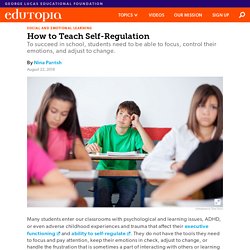
They do not have the tools they need to focus and pay attention, keep their emotions in check, adjust to change, or handle the frustration that is sometimes a part of interacting with others or learning something new. This can make it very challenging to complete required tasks in the classroom. As a middle school special education teacher, I quickly determined that in order to make learning accessible to these students, I had to first work on developing their self-regulation skills. As a new teacher, you may also struggle with teaching effective self-regulation to students. 7 Ways to Increase a Student's Attention Span. Children often struggle to pay attention, but when they are given a task they view as challenging or hard, they are even more likely to give up before truly trying.
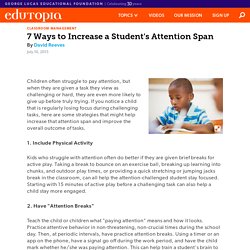
If you notice a child that is regularly losing focus during challenging tasks, here are some strategies that might help increase that attention span and improve the overall outcome of tasks. 1. Include Physical Activity Kids who struggle with attention often do better if they are given brief breaks for active play. Taking a break to bounce on an exercise ball, breaking up learning into chunks, and outdoor play times, or providing a quick stretching or jumping jacks break in the classroom, can all help the attention-challenged student stay focused. 2.
The Most Powerful Way to Remember What You Study. When Rote Learning Makes Sense. As a youth, I remember feeling cheated out of rich content in my education when I listened to my mother in times of sorrow or tenderness, lovingly recite entire poems and passages from books she studied in high school.

We all know that practice makes perfect, but for some reason perfection is not one of the goals of learning in most schools. In today's classrooms, students practice plenty, but are not required to retain knowledge perfectly. The M Word Somewhere along the way, rote learning got a bad rap. Memorization (there, I said the M word) became anathema to learning. The true nature of memorization, however, is not for the teachers at all, really.
The total emphasis on critical thinking has it all wrong: Before students can think critically, they need to have something to think about in their brains. How working memory games can improve kids' executive function in 5 minutes a day. Are there kids in your class that struggle with multi-step directions and need frequent reminders about what to do?
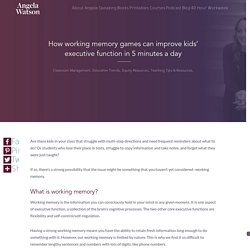
Or students who lose their place in texts, struggle to copy information and take notes, and forget what they were just taught? If so, there’s a strong possibility that the issue might be something that you haven’t yet considered–working memory. What is working memory? Working memory is the information you can consciously hold in your mind in any given moment. It is one aspect of executive function, a collection of the brain’s cognitive processes.
Having a strong working memory means you have the ability to retain fresh information long enough to do something with it. Best Buddies 'can change your life;' Program promotes inclusion. The goal is to create as many friendships as possible for students with and without intellectual disabilities “The goal is to create as many friendships as possible for students with and without intellectual disabilities,” said Steven Pinnock, executive director of Best Buddies Canada.
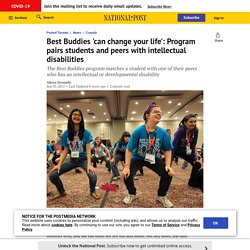
Best Buddies runs chapters in high schools, colleges and universities. In 2006, only 85 chapters existed, but six years later, there are 270 across Canada and approximately 6,000 student volunteers. We're More Alike Than Different. "NOT Acceptable" - "R-Word" PSA , starring Glee's Jane Lynch & Lauren Potter (UltimateGleeks) Restaurant Owner Tim Harris: "I Have Down Syndrome. I Am Awesome." Outlining, Writing, & Brainstorming using Mapping, Graphic Organizers and other Visual Thinking Techniques.
For visual mapping, outlining, writing and making presentations, use Inspiration® 9, the ultimate thinking and learning tool. Typing Course. Nuance - Conversational AI for Healthcare and Customer Engagement. Assistive Learning Technologies & Literacy Software from Kurzweil Education. What Are Learning Disabilities? Teaching Strategies for Students with Special Needs. Teaching the Gifted - Professionally Speaking -March 2012. BY GABRIELLE BAUER and ILLUSTRATION BY RÉMY SIMARD IT'S 9 AM IN THE GRADE 8 CLASSROOM of Rima Srinivasan, OCT.
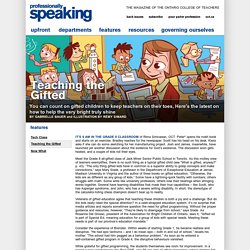
Peter* opens his math book and starts on an exercise. Bradley reaches for the newspaper. Scott has his head on his desk. Kiera asks if she can do some sketching for her manufacturing project. Meet the Grade 8 all-gifted class of Jack Miner Senior Public School in Toronto. Veterans of gifted education agree that teaching these children is both a joy and a challenge. Consider the experience of Brendan. Animal School. The power of inclusive education. Gifted and Talented Students: Teaching Strategies. Peer Modeling.
Peer modeling provides children with the opportunity to learn social skills from typically developing peers through games and activities.
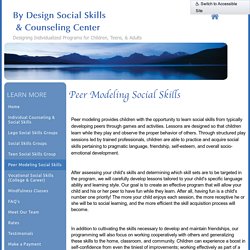
Lessons are designed so that children learn while they play and observe the proper behavior of others. Through structured play sessions led by trained professionals, children are able to practice and acquire social skills pertaining to pragmatic language, friendship, self-esteem, and overall socio-emotional development. After assessing your child's skills and determining which skill sets are to be targeted in the program, we will carefully develop lessons tailored to your child's specific language ability and learning style.
Our goal is to create an effective program that will allow your child and his or her peer to have fun while they learn. After all, having fun is a child's number one priority! Your child's programming is customized to fit his or her unique needs. . * Attending Skills (Eye Contact, Responding to others) * Conversation Skills. 21 Awesome Kids Books About Feelings and Emotions. I am a huge fan of using books as a resource to open discussion with kids about all manner of situations and problems.
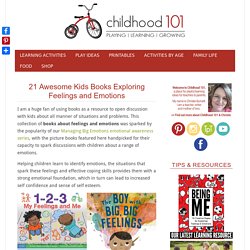
This collection of books about feelings and emotions was sparked by the popularity of our Managing Big Emotions emotional awareness series, with the picture books featured here handpicked for their capacity to spark discussions with children about a range of emotions. Helping children learn to identify emotions, the situations that spark these feelings and effective coping skills provides them with a strong emotional foundation, which in turn can lead to increased self confidence and sense of self esteem.
EDBE 8P03 Lookingfor DI .docx. DI Strategies. DI Reference Card. DI Reference Card 1. DI blank lesson plan template. 8P03 Session 3 .pdf. DI Structures and Examples.